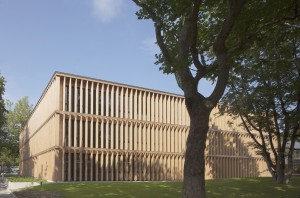The forest - what an achievement!

Storms, drought and insect infestations have caused a great deal of damage to Germany's forests over the past three years. The "International Day of Forests" on 21 March is a good time to become aware of the many services provided by the forest.
"Rebuilding Forests - A Pathway to Recreation and Well-Being".is the motto of the Food and Agriculture Organization of the United Nations (FAO) for this year's "International Day of Forests". The Food and Agriculture Organization is thus drawing attention to two things:
- There is a need for action in reforestation. It is not for nothing that this day was also chosen as the starting point of the UN Decade for the Restoration of Ecosystems (2021-2030). The necessary measures vary from region to region. In Germany, storm damage, drought and beetle infestations have recently led to record tree deaths. In some areas, entire forests are drought-stricken. According to the latest forest condition report, only 20 percent of forest trees still have a healthy crown. But reconstruction is in full swing. The Federal Government, through the Federal Ministry of Food and Agriculture (BMEL), is supporting reforestation and sustainable forest management with comprehensive financial aid. 277,000 hectares will be reforested over the next few years. Important projects on the broad range of forest issues are supported by the Support programme for renewable raw materials of the BMEL and with the Forest Climate Fund which the BMEL is supporting together with the Federal Ministry for the Environment, Nature Conservation and Nuclear Safety (BMU).
- With eight key messages the FAO shows how human well-being is closely linked to the condition of forests - and not just through climate change.
For the forest provides us with a cornucopia of Ecosystem services:
- Living and working space forest: This does not only concern indigenous peoples who live in or with the forest and who are directly affected by the destruction of the forests. Even in an industrialised country like Germany, people live from the forest and its products: More than one million people are employed in the forest and timber economic cluster in this country.
- Recreational forest: Germany is a forest country with a forest area share of 32 percent. Germans are traditionally said to have a close relationship with the forest. Statistically, this is expressed in over two billion visits to the forest each year. More than two thirds of Germans regularly visit the forest. On average, each visitor spends at least 20 minutes in the "green lungs". Recreation is the number one reason for visiting the forest.
- Climate protector forest: With climate change, we are reminded of the importance of the carbon storage capacity in the biomass of forests. Through photosynthesis, trees remove the greenhouse gas carbon dioxide (CO2) from the atmosphere. In this way, forests counteract climate change. Over 4.5 billion tons of CO2 are bound in the forest. Per hectare, this adds up to the equivalent of 114 tonnes of carbon in our domestic forests.
- Biodiversity: More than 10,000 animal and plant species live in Germany's forests, making them a hotspot of biological diversity. In our forests there are almost 200 species of trees and shrubs, more than 1,000 herbaceous plant species, almost 700 different mosses and more than 1,000 different species of lichens as well as uncounted species of fungi. And from red deer to the dwarf shrew, 140 different vertebrate species live in Germany's forests.
- Many other ecosystem services of the forest, such as oxygen production, air cooling and air filtration, usually receive too little attention. Yet forests, water, soil and atmosphere are inextricably linked. The forest body forms the link between the elements: For example, forests have a considerable influence on the atmospheric as well as the soil water cycle with their evaporation rate. They retain surface water with their rough structure and, together with their gigantic root system, provide formidable protection against erosion. In mountain forests, this network even forms the most important avalanche protection. And on top of that, forests are soil builders - at one centimetre in 100 years, it may seem slow to us. On a geological scale, however, it is rapid.
An overview of the Ecosystem services offered by the infographic.
Keywords: DE-News, Wood construction, Climate protection, Environmental policy, Life cycle assessment





